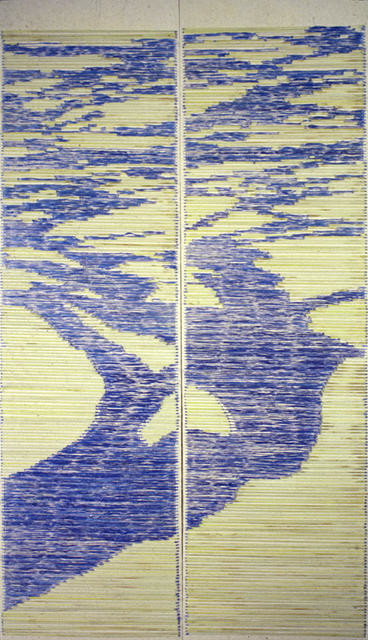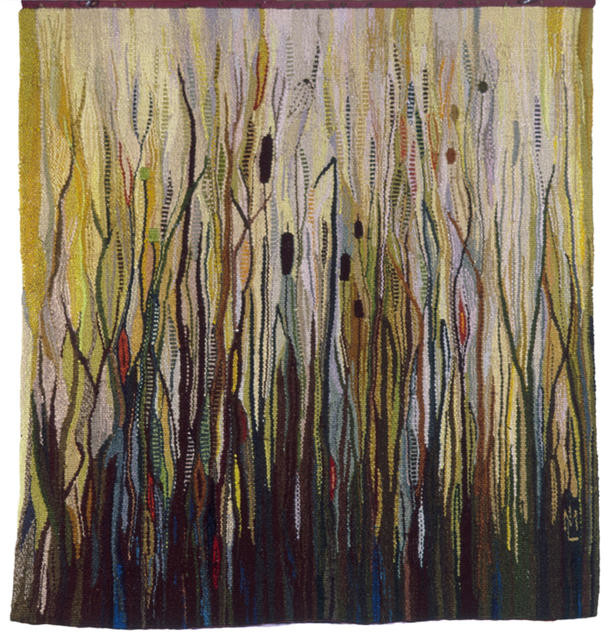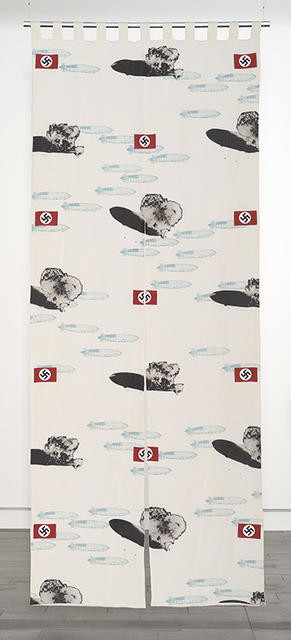B.
A Stitch in Time
Collection
Textiles comprise a small proportion of the Gallery's Collections, yet they span a vast time period, combining Chinese antiques and 17th century appliqué with fabric-based work made as recently as 2000. The diverse range of practice is indicative of the evolution, in form and content, of textile-based works from objects dedicated to religious worship and domestic decoration to conceptual art objects which exist outside a strictly functional context.

Michael Reed Binding statements 1999-2000. Cotton crepe bandages, some dyed red, with black silkscreen printing. Collection of Christchurch Art Gallery Te Puna o Waiwhetū, purchased 2000. Reproduced with permission
One of the oldest works in the Collection is The Pascal Lamb, made by an unknown artist, which has been dated to c.1660 AD. This appliqué work (a technique where shapes are cut from one piece of fabric and applied to another) combines silver thread, satin fabric and a red velvet background to depict a common heraldic subject, a white lamb carrying a banner. The lamb is a familiar symbol in Christian art, where it is the emblem of the Redeemer and also the attribute of several saints, including St. Agnes, St. Catherine and St. John the Baptist. The subject of this particular work, the Pascal (or Paschal) Lamb, is the animal sacrificed and eaten at the Jewish Passover, a festival commemorating the liberation of Israelites from Egyptian bondage. For Christians, Jesus Christ is identified with the Paschal Lamb because the meal which became the Last Supper began as a Passover feast. Christ was then referred to as the Lamb of God: John 1:29: "Behold the Lamb of God, which taketh away the sin of the world", 1 Corinthians 5:7: "For even Christ our passover is sacrificed for us".
The Lamb in this work is shown passant, that is, walking and looking to the dexter side (the right side of the composition, which is the viewer's left) with three feet on the ground and one raised. With this raised hoof, the Lamb supports the banner of St George, the patron saint of England, whose legendary slaying of a dragon symbolised the triumph of Christianity over evil. The Pascal Lamb was purchased in 1972 from an Auckland antique dealer by Brian Muir (Director of the Gallery between 1969 and 1978) as part of a strategy (common in museological practice at that time) to contextualise the collection by augmenting historical artworks with period furniture and other domestic items. The Lamb has not survived its long period of existence without accumulating several marks of age, as the velvet background has lost much of its pile and colour intensity and the satin fabric is worn in places, revealing a coarse plain-weave support fabric behind. A slight crease down the centre of the fabric suggests that The Lamb spent at least some of its history folded in half.
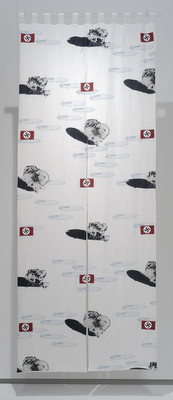
Jennifer Matheson Being air 2000. Screenprint on linen and ramie, acrylic rod. Collection of Christchurch Art Gallery Te Puna o Waiwhetū, purchased 2000. Reproduced with permission
A silk embroidery, identified as 'possibly from a Mandarin's Robe', which was presented to the Gallery by Mrs G. L. Montfort of Christchurch in 1976 is another of the older textiles held by the Gallery. The largely blue and cream composition teems with a profusion of flower clusters and butterflies, suggesting light and shadow through different sections of colour. Like The Pascal Lamb, this textile had become increasingly faded and worn over time and was extensively conserved after being acquired by the Gallery.
The majority of the textile collection was accumulated in the 1970s and 80s and includes works by Gordon Crook, Sally Ann Griggs, Esther Archdall, Marie Abbot, Ruth Dean and Peter Collingwood. In addition to the works held within the Gallery, the Collection also includes the Women's Suffrage Commemorative Wall Hanging, which was designed by Di ffrench and embroidered by one hundred members of the Canterbury Embroiderer's Guild. The hanging, completed in 1993 to celebrate the 100th anniversary of New Zealand women gaining the right to vote, now hangs permanently in the Christchurch Town Hall.
The Collection includes three works by Ida Lough (1907-1985), one of the pioneers of hand weaving and tapestry in New Zealand. On an early trip to Europe, Lough was struck by the beauty of the Mille Fleurs tapestries in the Cluny Museum in Paris. After viewing weavings in Scandinavia in the mid 1950s, she returned to Christchurch determined to become a weaver. Little instruction was available at the time and Lough was largely self-taught, but she did receive tutoring in the basics of weaving from the occupational therapist at Burwood Hospital (who was later to become Lady Hay). Lough's work has been exhibited throughout New Zealand, and internationally in Stuttgart, Toronto, London, Tokyo, Sydney and Europe. In 1975, she was commissioned to contribute a large tapestry for the interior of the newly renovated Roman Catholic Basilica in Christchurch, which she worked on in close collaboration with sculptor Ria Bancroft. Unlike most weavers, Lough did not work from preparatory designs, but rather designed her tapestries as she wove, working from her own memories of shapes and colours found in nature. The tapestry Water Grasses (1974), purchased for the Collection with assistance from the Olive Stirrat Bequest in 1988, is a good example of Lough's interest in simple and fluid organic forms.
Christchurch-based fibre artist Vivienne Mountfort, who has exhibited in New Zealand, Australia, Japan, Europe and the United States of America is also represented in the Collection by three works. One of these, Life is Like a Long Braided River (1996) is constructed from New Zealand flax, handmade flax paper and mineral dyes. By drawing on the characteristic braided form of the Waimakariri River, Mountfort conveys the complex and interwoven nature of human existence. The innovative application of materials, and use of natural elements to reflect personal and universal concerns within this work, are typical of Mountfort's practice.
Two recent acquisitions, Jennifer Matheson's Being Air (2000) and Michael Reed's Binding Statements (1999 - 2000) are conceptual works which expand at the boundaries of textile or fibre art whilst employing and drawing on the resonances of their chosen materials. The elegant, flowing form of Being Air takes its shape from the noren, or split Japanese curtain. The ambiguous nature of this object, at once an entrance and a screen, is suggestive of a transition from one zone to another, a reading reinforced by the screen-printed design, which depicts the 1937 Hindenburg air disaster. The wall of red crepe bandages in Reed's Binding Statements provoke immediate associations with the violence and danger of warfare, while silk-screened phrases such as 'Alms/Arms' and 'Genocide = Business' combine with the frayed edges of the crepe strips to powerfully convey the artist's outrage and disillusionment at the profit margins that lurk behind many civil wars.
Not withstanding the popularity of travelling fibre-based exhibitions such as U.S. and US (which was displayed at the Gallery in 1997), space limitations at Christchurch Art Gallery Te Puna o Waiwhetū have meant that the textiles in the Collection have often remained in storage. Fortunately however, this situation has been remedied in the design for the new Art Gallery, in which space has been set aside in the Monica Richards Gallery to permanently display a selection of textiles. This will provide far greater opportunities for visitors to appreciate and enjoy a collection representing a wide spectrum of cultural responses across time.
Felicity Milburn
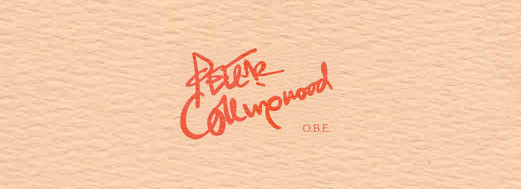
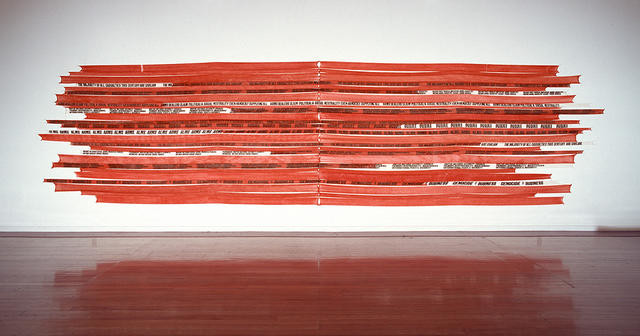
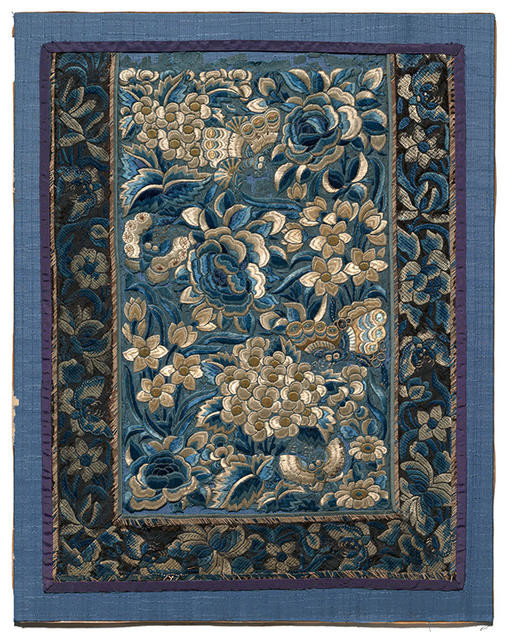
![Dalmatic Panel, Agnus Dei [Lamb of God]](/media/cache/d6/e0/d6e0582759bf7295660754abae7bcb7a.jpg)
